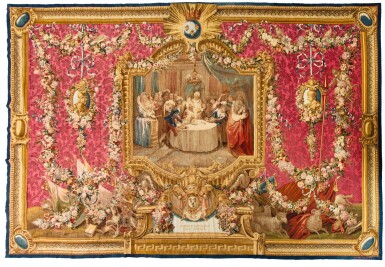Hôtel Lambert, Une Collection Princière, Volume I : Chefs-d’oeuvre
Hôtel Lambert, Une Collection Princière, Volume I : Chefs-d’oeuvre

A Royal Louis XV Literary Tapestry, from The Story of Don Quichotte, Gobelins manufactory, under direction of Michel Audran (1701-1771)
Auction Closed
October 11, 05:25 PM GMT
Estimate
80,000 - 120,000 EUR
Lot Details
Description
A Royal Louis XV Literary Tapestry, from The Story of Don Quichotte, Gobelins manufactory, under direction of Michel Audran (1701-1771)
after designs by Charles Antoine Coypel (1694-1752), Jean-Baptiste Belin de Fontenay the Elder (1653-1715) and Claude Audran III (1658-1734), with border designs of 1714-1751, by Jean-Baptiste Belin de Fontenay the Younger (1688-1730) and Alexandre Francois Desportes (1661-1743);
wool and silk; signed AUDRAN in the bottom right and dated in blue 1772, inscribed: DONNE PAR LE ROY A JB DE MACHAULT GARDE DES SCEAUX DE FRANCE EN 1783, representing Sancho's meal in the island of Barataria, after a design by Charles Antoine Coypel (1694- 1752), surrounded by a cramoisi damask pattern, with garlands of flowers and fruits, the border with stitch patterns
approx. 146½in. x 214½in.; 372 x 545 cm.
____________________________________________
Tapisserie Royale de la Manufacture royale des Gobelins d'époque Louis XV, de l'atelier d'Audran et de Cozette, signée et datée 1772, représentant Le repas de Sancho sur l'île de Barataria, tirée de L'Histoire de Don Quichotte
approx. 146½in. x 214½in.; 372 x 545 cm.
Offered by Louis XVI to Jean-Baptiste de Machault d'Arnouville (1701-1794) in 1783;
by descent to his great-granddaughter, Henriette de Machault (1808-1864);
by descent to his grandson Louis de Vogüé (1868-1948);
by descent to an aristocratic French collector sold Christie's London, The Exceptional Sale, 28 November 2017, lot 719.
____________________________________________
Offerte par Louis XVI à Jean-Baptiste de Machault d'Arnouville (1701-1794) en 1783 ;
par descendance à son arrière-petite-fille, Henriette de Machault (1808-1864) ;
par descendance à son petit-fils Louis de Vogüé (1868-1948) ;
par descendance à un aristocrate français collectionneur vente Christie's Londres, The Exceptional Sale, 28 novembre 2017, lot 719.
V. Pruchnicki Arnouville, Le château des Machault au XVIII' siècle, 2013, pp. 82-86 (ilL p. 83).
S. de Monicault, "Léonce de Vogüé, un collectionneur de meubles Boulle à la fin du XIXe siècle", 2012, L'Estampille -L'Objet d'Art, no. 478 (avril 2012), pp. 80-83.
Robert Cecil, The Hertford Wallace Collection of Tapestries, The Burlington Magazine no.637 April 1956, pp.116-118.
Robert Cecil, "The Hertford Wallace Collection of Tapestries", The Burlington Magazine, no. 660 March 1958, p.101.
Maurice Fenaille, Etat General des Tapisseries de la Maufacture des Gobelins, Paris, 1904 IIII pp.219-229.
K.L Selig, The Battle of the Sheep (Don Quixote, I, Xviii), Revista Hispánica Moderna 38, no. 1/2 (1974) pp.64–72.
Edith Standen, The Memorable Judgement of Sancho Panza, A Gobelins Tapestry, Metropolitan Museum Journal X, 1975 p.103.
Edith Standen European Post-Medieval Tapestries and Related Hangings in the Metropolitan Museum of Art, New York, 1985 p.373.
Edith Standen, Madame de Pompadour's Gobelins Tapestries, Studies in the History of Art, vol. 42, 1993, pp.14–33.
Gillian Wilson and Catherine Hess, Summary Catalogue of European Decorative Arts in the J. Paul Getty Museum, 2002, p.154.
Composed each of six pieces from cartons executed around 1715 by Charles Coypel, Painter of the King, these Hangings of the History of Don Quixote are drawn from the famous literary work by Cervantes. This hanging was designed under the direction of Robert de Cotte (1656 -1735), first architect of the King, director of Gobelins (1699 - 1735) and the Duke of Antin, Superintendent of Buildings of the King (1708 - 1736). It was woven for the first time in 1717 for the Duke of Antin, himself (this tapestry comprising sixteen pieces was sold by Christie's in London, on June 10, 1993, lot 110).
This tapestry marks the beginning of a new Gobelins fashion. With this lively and frivolous subject, we are far from the sobriety of the classic and military themes that were in favor under Louis XIV. An innovative design, the background or surroundings, which appears here for the first time, is treated with the same precision as the scene itself. The tapestry of the story of Don Quixote, very popular throughout the 18th century, would be woven at least nine times, decorated with six different surroundings, between 1717 and 1778.
The present tapestry is part of the eighth hanging with crimson damask background executed by the workshops Audran and Cozette between 1763 and 1787; Don Quixote among the daughters of the inn was started in October 1773 and completed December 30, 1776. The tapestry comes from a hanging granted in 1783 by King Louis XVI to Monsieur de Machaut, Keeper of the Seals under the reign of Louis XV from 1750 to 1757. It was customary for a Gobelins wall hanging to be given to those who had filled the role of Chancellor or Keeper of the Seals. Monsieur de Machault had not received one. His family, therefore, remarked on this to Monsieur d'Angivilliers, Superintendent of the Buildings, who solicited from his Majesty the King Louis XVI to kindly authorise him to deliver this hanging. The king granted this request by his voucher of May 26, 1783. It included Le Bal, Don Quixote and the hotel girls, the Departure of Sancho for the island of Barataria, Don Quixote served by the ladies, the Dorothea, the Sancho meal. In 1784, the manufacturing account of the workshop of Cozette carries the interventions made on this wall hanging to adapt them to the quality of the recipient: "The arms of France replaced the peacock and the weapons of Machault were placed below the table". These tapestries, kept in the family of Monsieur de Machault, carry his weapons: "money with three heads of crows dripping sand Gules".
